Related Research Articles

The Hallam Line is a railway connecting Leeds and Sheffield via Castleford in the West Yorkshire Metro area of northern England. It is a slower route from Leeds to Sheffield than the Wakefield line. Services on this line are operated by Northern Trains. Services from Leeds to Nottingham also use the line.

The Penistone Line is operated by Northern Trains in the West Yorkshire Metro and Travel South Yorkshire areas of northern England. It connects Huddersfield and Sheffield via Penistone and Barnsley, serving many rural communities. Metrocards can be used for travel between Huddersfield and Denby Dale and intermediate stations.
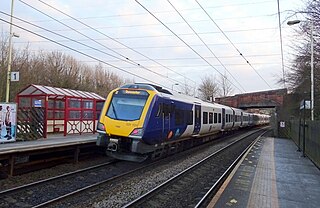
The Wakefield line is a railway line and service in the West Yorkshire Metro and South Yorkshire Passenger Transport Executive areas of northern England. The Wakefield line is coloured yellow on maps and publications by West Yorkshire Metro. The line was electrified in 1989, between Leeds & Wakefield Westgate, as part of the programme to electrify the East Coast Main Line.

The Dearne Valley line is the name given to a railway line in the north of England running from York to Sheffield via Pontefract Baghill and Moorthorpe. The route was built over several years and consists of lines built by several railway companies.

Meadowhall Interchange is a transport interchange located in north-east Sheffield, consisting of a combined heavy rail station, tram stop and bus and coach station. The second-busiest heavy rail station in the city in terms of passenger numbers, Meadowhall Interchange provides connections between National Rail services, the Sheffield Supertram light rail network, intercity coach services and the city bus network.
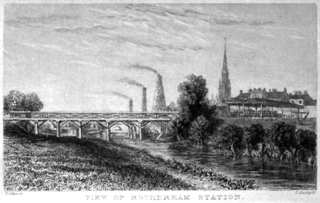
The Sheffield and Rotherham Railway was a railway line in England, between the named places. The North Midland Railway was being promoted but its route was planned to go through Rotherham and by-pass Sheffield, so the S&RR was built as a connecting line. It opened in 1838. In Sheffield it opened a terminal station at Wicker, and in Rotherham at Westgate. When the NMR opened in 1840 a connecting curve was made between the two routes.

Barnsley Interchange is a combined rail and bus station in the centre of Barnsley, South Yorkshire. It was first opened in 1850 as Barnsley Exchange railway station and is 16 miles (26 km) north of Sheffield. It is on the Hallam and Penistone Lines, both operated by Northern Trains. On 20 May 2007, the new bus station and refurbished railway station were officially opened by Travel South Yorkshire, with the combined facility renamed to Barnsley Interchange.

Mexborough railway station serves the former mining town of Mexborough, South Yorkshire, England. It is a station on the Sheffield to Doncaster Line 7 miles (11 km) south west of Doncaster.

Hazel Grove railway station is a junction on both the Stockport to Buxton and Stockport to Sheffield lines, serving the village of Hazel Grove, Greater Manchester, England.

Guide Bridge railway station serves Guide Bridge in Audenshaw, Greater Manchester, England, and is operated by Northern Trains. The station is 4+3⁄4 miles (7.6 km) east of Manchester Piccadilly on both the Rose Hill Marple and Glossop Lines.

Transport in Sheffield, England is developed around the city's unusual topography and medieval street plan. Once an isolated town, the transport infrastructure changed dramatically in the 19th and 20th centuries. The city now has road and rail links with the rest of the country, and road, bus and trams for local transport.

Tinsley was a railway marshalling yard near Tinsley in Sheffield, England, used to separate railway wagons from incoming trains and add them to new trains. It was sited immediately west of the M1 motorway, about one mile north of the Catcliffe junction. It was opened in 1965, as a part of a major plan to rationalise all aspects of the rail services in the Sheffield area; it closed in stages from 1985, with the run-down of rail freight in Britain. It was also the site of Tinsley Traction Maintenance Depot (TMD), which was closed in 1998; at its peak, 200 locomotives were allocated to this depot.

Tinsley railway station was a railway station in Sheffield, South Yorkshire, England, opened in March 1869. This station was designed by the company architect John Holloway Sanders. The station served the growing community of Tinsley and the workers at the nearby steelworks which had moved to or had been founded in the lower Don Valley following major changes in manufacturing methods in the mid - late 19th century. The station, opened by the South Yorkshire Railway, was built on the line between Sheffield Victoria and Barnsley and became a junction station with the opening of the line from Tinsley Junction to the original Rotherham station by the Manchester, Sheffield and Lincolnshire Railway. The station was located by the main Sheffield to Rotherham road in Tinsley, now on the Sheffield side of M1, Junction 34 in Tinsley.

Sheffield Tramway was an extensive tramway network serving the English city of Sheffield and its suburbs.
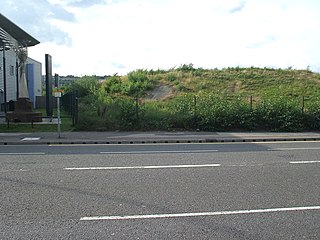
West Tinsley railway station is a former railway station in Sheffield, South Yorkshire, England.
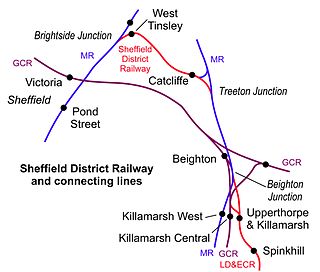
The Sheffield District Railway was a 3+1⁄2-mile (6 km) railway line in South Yorkshire, England. It was built to give the Lancashire, Derbyshire and East Coast Railway access to Sheffield, primarily for goods traffic, for which a large goods depot at Attercliffe, in Sheffield, was built. The construction was sponsored by the LD&ECR and the Great Eastern Railway together, with the support of the Midland Railway, which agreed running powers over sections of its own lines. The Sheffield District Railway opened in 1900. The LD&ECR operated the passenger service, although the Midland Railway later ran passenger trains too. The SDR did not have rolling stock and did not operate trains itself. The LD&ECR was absorbed by the Great Central Railway in 1907, and the GCR inherited the LD&ECR running powers.
Wincobank railway station, previously named Wincobank and Meadow Hall, was a railway station in Sheffield, South Yorkshire, England. The station served the communities of Brightside and Wincobank and was situated on the Midland Main Line on Meadowhall Road, lying between Holmes and Brightside stations. There were no platforms on the Midland Railway line to Barnsley at the original Wincobank station. This was remedied when Meadowhall Interchange was later built on roughly the same site.
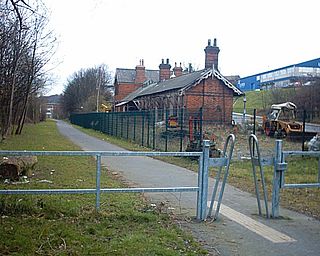
Meadowhall and Wincobank railway station—also known in the 19th century as Meadow Hall at the time of the Meadow Hall Iron Works—was a railway station on the South Yorkshire Railway near Sheffield, England.

Catcliffe railway station is a former railway station in the Catcliffe area of Rotherham, South Yorkshire, England.
Beighton Junction is a set of railway junctions near Beighton on the border between Derbyshire and South Yorkshire, England.
References
- South Yorkshire County Council 10 year Transport Plan, published 1990.
- British Railways Working Timetables
- Sheffield A-Z, ISBN 0-85039-862-2, Published by Geographers' A-Z Map Company Ltd.,2005 edition, Ref. H1, Page (Map) 115.